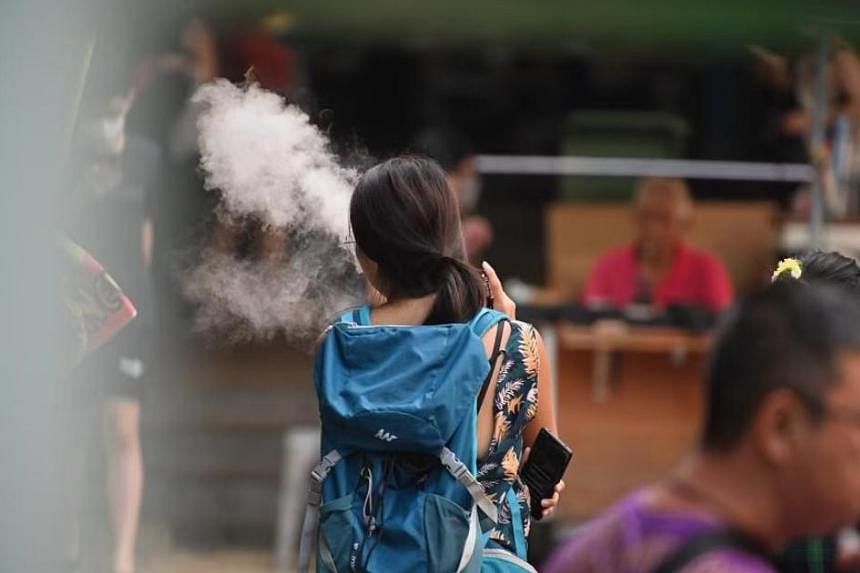SINGAPORE – Doctors treating respiratory issues are not always aware if their patients have been vaping. Therefore, cases are not tracked systematically at hospitals because these patients are not always willing to share their vaping history.
With the clampdown on vaping and the authorities stepping up checks, even in public hot spots such as the Central Business District, parks, malls and bars, patients with breathing issues caused by vaping are aware and are keeping mum.
Dr Sewa Duu Wen, who heads the department of respiratory and critical care medicine at Singapore General Hospital, told The Straits Times about one case of a patient who had been smoking e-cigarettes.
“We have reported (a case) where a patient developed respiratory failure due to abnormal build-up of protein and fatty material within the air sac (in the lungs) after having started vaping.”
He said the man underwent an uncommon treatment procedure, termed whole lung lavage, at the hospital. Sometimes called lung washing, the treatment is a specific procedure that uses saline solution to “wash out” the lungs.
“There are also (other) anecdotal cases of patients who were admitted for exacerbation of asthma and lung conditions after starting on vaping,” Dr Sewa added.
Experts are sounding the alarm on the dangers of vaping amid a global spike in the use of disposable vapes and e-cigarettes, especially among teenagers and young adults.
According to peer-reviewed journal Emerald Insight, the number of vape users was estimated to be 82 million worldwide in 2021, with 14.3 million in South-east Asia, and the global e-cigarette and vape market was valued at US$22.8 billion (S$31 billion) in 2022.
From data of individual countries, it looks like there has been an alarming rise in vaping, especially among teenagers and young adults in their 20s around the world.
According to the US National Centre for Health Statistics, people aged 18 to 24 were most likely to use e-cigarettes among all adults in 2021. In the same year, 69 per cent of vape users in Britain were 11 to 17 years old.
It is no wonder, as vaping vendors often market their products as “healthier” alternatives to cigarettes or even as a way to quit smoking.
They claim e-cigarette “smoke” generally contains fewer toxic chemicals than the deadly mix of 7,000 chemicals in smoke from regular cigarettes.
However, the World Health Organisation in December 2023 urged governments to treat e-cigarettes in a similar way to tobacco, and ban all flavours.
Dr Sewa said e-cigarettes generate an aerosol of fine particles by activating a heating element to a reservoir containing vape liquid.
This liquid usually contains propylene glycol (a colourless and nearly odourless synthetic liquid), glycerine, flavouring additives and nicotine, exposing the user to higher levels of toxins.
“There are still many harmful chemicals such as carcinogens, toxicants, heavy metal and nanometallic particles in e-cigarette vapour, which have harmful effects on the body. There is no minimal level of these compounds which are considered safe to be inhaled into our body,” he said, adding that there has been little research done on the long-term effects of vaping.
In Singapore, the vaping situation has been worsening steadily. The purchase, use or possession of vapes jumped 58 per cent to about 7,900 cases in 2023, from about 5,000 cases in 2022.
Dr Sewa said that with the evolution of e-cigarettes into more “personalised” devices, and manufacturers adding different flavours and additives, the risks of some of these chemicals are now being recognised.
“There is substantial evidence that some chemicals present in e-cigarette aerosols, such as formaldehyde and acrolein, together with the trace metals nickel, lead and cadmium, are capable of causing DNA damage and mutagenesis, with potential carcinogenic effects,” he added.
Many vape devices offer flavours such as cotton candy, cupcake, butterscotch, pop rocks and peanut butter to increase attractiveness to young people.
Second Minister for Education Maliki Osman told Parliament in October 2023 that about 800 students were referred to the Health Sciences Authority for vaping offences in 2022. This is an increase from 2019 and 2018, when the total for both years was fewer than 50.
He said that although schools and institutes of higher learning have stepped up checks in recent years, it is likely that there is under-detection.
Dr Maliki’s ministry had previously revealed that an average of about seven in every 1,000 students in primary and secondary schools and institutes of higher learning had been caught for smoking and vaping offences.
Students at dormitories in the NUS, NTU and SMU campuses had said in September 2023 that vaping culture still persists on campus, with some residents reselling vaporisers that were bought in bulk from dealers.
“While considered safe when consumed, these flavours are linked to serious health diseases during aerosolisation and inhalation. Take diacetyl for example, a chemical used to create a buttery flavour. It has been associated with the development of ‘popcorn lung’ or bronchiolitis obliterans, a serious lung disease causing chronic breathlessness,” Dr Sewa said.
According to the American Lung Association, diacetyl scars the tiny air sacs in the lungs, resulting in thickening and narrowing of the airways.
Dr Philip Eng, a senior consultant respiratory physician with his own practice, said vaping-induced lung injury, called Evali, was an epidemic in the US in 2019.
The Centres for Disease Control and Prevention in the US reported more than 2,000 suspected cases of severe lung illness related to vaping in 2019. Of these, there were more than 60 deaths.
Dr Eng said: “Such severe cases causing hospitalisation and death have never been reported in Singapore.”
Dr Sewa said while the exact mechanism is not known, it is thought that the compound tetrahydrocannabinoid found in cannabis, when mixed with vitamin E acetate in some of these e-cigarettes, appears to be most strongly associated with the development of lung disease due to vaping.
The most recent case was of a British woman, Ms Abby Flynn, 20, whose addiction to vaping left her hospitalised with “popcorn lung” in January 2023.
She had never smoked a cigarette before but took up vaping in summer 2021 because it was “trendy”.
She had consumed an entire cartridge of vape liquid a day, the equivalent of 140 cigarettes a week, for about 1½ years.
Doctors told her that if she did not kick the habit, she would be forced to rely on an oxygen machine by the time she was 30.
She has since thrown her vapes into the bin.
Buying, owning or using an e-cigarette or vaporiser here can result in fines of up to $2,000.
First-time offenders who import, distribute, sell or offer for sale e-vaporisers and their components can be fined up to $10,000, jailed for up to six months, or both.



